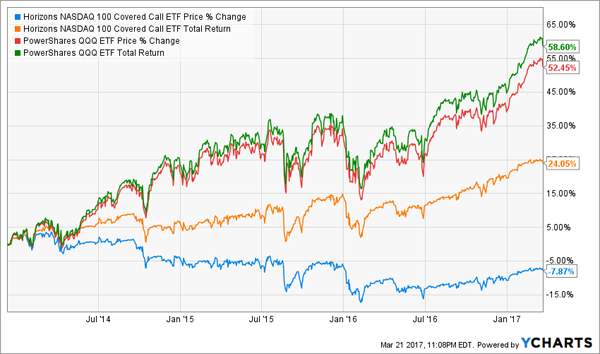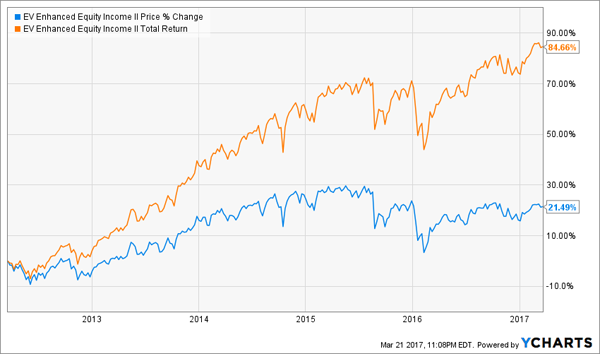If you’re worried about a pullback, I don’t blame you. But don’t sit in cash and earn nothing when you can hedge your portfolio AND collect yields up to 8%.
Let’s talk about a couple of funds that use a well-worn options tactic – writing “covered calls” – that can generate generous yields typically between 7% and 9%. Conveniently, you never have to deal with the complications of options contracts – these funds do all the work for you!
But, why covered calls, and why now?
Covered calls are an options strategy in which you sell call option contracts against stocks you hold. Selling the call options generates income, called a “premium.” From there, a couple things can happen. If your stock reaches the strike price of the call option, you’re obligated to sell your shares to the call buyer (but you still keep the premium). If your stock stays below the strike price, you still keep the premium, and you can keep your shares – and from there, if you’d like, you can keep selling covered calls against them for more income.
Ziegler Capital Management, a specialty investment bank out of Chicago, extols the virtues of covered calls (emphasis mine):
“Investors often consider the income from the sale of the call option as a form of downside protection. As a result of this income, covered call strategies have historically generated impressive results compared to the S&P 500 Index in terms of risk mitigation and volatility reduction. … Over a market cycle, covered call strategies have tended to produce equity-like returns with lower beta and lower volatility.”
This strategy does limit your upside during raging bull markets, but whether we’re about to fly into some market turbulence, or on the slim chance that a significant downturn is nigh, covered calls are the place to be.
And if you don’t want to deal with the complexity of trading options, don’t worry. There are a number of exchange-traded funds and closed-end funds that do all the heavy lifting and deliver substantial income with lower volatility.
Of course … some funds are better than others.
Recon Capital Nasdaq 100 Covered Call ETF (QYLD)
Dividend Yield: 8%
The Recon Capital Nasdaq 100 Covered Call ETF (QYLD) is an exchange-traded fund that executes the covered call strategy in a simple, straightforward way against the Nasdaq-100. That’s a good place to start, as the Nasdaq-100 – which is composed of the 100 largest non-financial companies on the Nasdaq, including stocks like Apple (AAPL), Alphabet (GOOGL) and Microsoft (MSFT) – offers solid large-cap exposure as a base.
For just 0.6 percent in annual fees, QYLD tracks an index that’s based on buying a Nasdaq-100 portfolio, then selling short-term covered calls (about one month to expiration) on the third Friday of each month.
If it sounds simple, it’s because it is – but that ultimately does a disservice to QYLD. This is a passive index that executes the same strategy, month after month, on a single index, without any regard to whether the fund is actually getting any value out of the premiums it’s collecting. In some cases, the premium isn’t nearly enough to cover the risk of selling the options.
As a result, QYLD – as I mentioned a few weeks ago – has been a dud. Despite a nearly 8% yield (paid monthly), QYLD hasn’t just trailed the annualized 15.3% return of the Nasdaq-100 since 2014 – which we would expect because of covered calls’ limited upside in bull markets – but at just 5.6% annualized, price losses have eaten away at investors’ income!
Recon Capital’s QYLD Has Been a Yield Trap for Years

Eaton Vance Enhanced Income Fund II (EOS)
Dividend Yield: 7.8%
Sometimes, cheap, passive investing works. If you haven’t already, I urge you to check out just how important low fees from index funds can be to long-term returns. But when it comes to covered calls, it pays to pay for quality managers.
The Eaton Vance Enhanced Income Fund (EOS) and its three-pronged management team of Michael Allison, Lewis Piantedosi and Yana Barton generate income not just from a single index, but from about 60 individual stocks, such as Amazon.com (AMZN), Visa (V) and Celgene (CELG). This allows EOS to pick its spots and grab premium when it makes the most sense – and avoid selling covered calls when doing so would be detrimental to returns. Case in point? At the end of 2016, EOS boasted sold contracts on less than half the portfolio!
And while Eaton Vance’s fund racks up a bit more in fees and expenses than QYLD, at 1.11%, it more than makes it up in performance. EOS boasts an annualized total return of 13% over the past five years – some capital gains to go with that meaty yield!
Eaton Vance’s EOS Packs a Total Return Punch

The Retirement Portfolio You NEVER Have to Touch!
If you want a retirement that you can actually enjoy, you’ll need a lot more than 8% yields that ultimately get you nowhere. You need the kinds of holdings that can throw off high-single-digit and even double-digit yields … but also give you a few percentage points in capital gains year-in and year-out.
And that’s exactly the kind of holdings you’ll find in my “No Withdrawal” retirement portfolio.
Too many investors are suckered into buying big-name large-cap blue chips that boast safety on the promise of “big” yields … of 3%, maybe 4% if you’re lucky. But these stocks more often than not can start to rot in your portfolio with dividend increases that don’t even keep up with inflation, and tiny capital gains because they’ve given up on growth a long, long time ago. And if you’re getting just 3% or 4% in returns out of these stocks, do you know what that translates to?
Annual retirement income of just $30,000, maybe $40,000 a year. Think you’ll get far on that?
You and I both know better.
That’s why I recommend a “No Withdrawal” retirement portfolio – a set of buy-and-hold dividend stocks that generate yields of 7%, 8%, or more … along with 7% to 15% upside in annual capital gains. That means you can live off dividend income alone without ever touching your nest egg – but if disaster strikes and you need to dip in, that’s OK, because you’ve grown your retirement account with these double-whammy dynamos.
What makes this portfolio so effective is that it’s an all-star makeup – rather than focusing on just one area of the market, it’s the best of the best preferred stocks, REITs, closed-end funds and more. That means diversification and continued payouts against the most volatile of markets.
Don’t spend your retirement hoping you can just get by on meager blue-chip returns and your Social Security checks. Collect big, regular dividend checks instead that will let you pay the bills, finance your vacations and even spoil your family.
This is the path to the worry-free retirement you deserve. Click here and I’ll provide you with THREE special reports that show you the path to building a “No Withdrawal” portfolio. You’ll get the names, tickers, buy prices and full analysis of their wealth-building potential – and it’s absolutely FREE!
